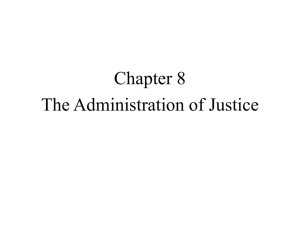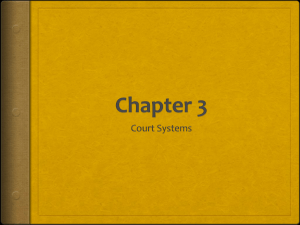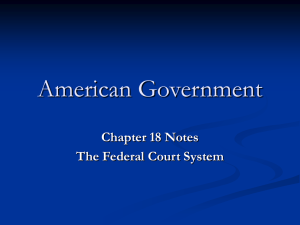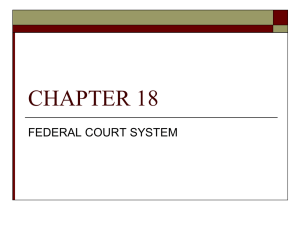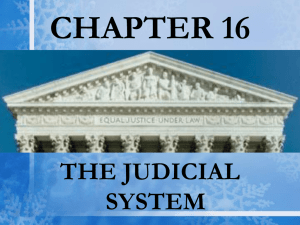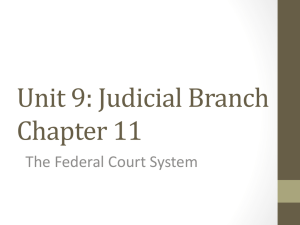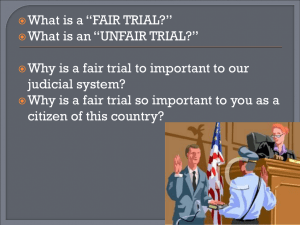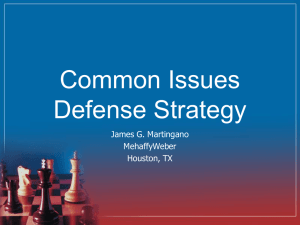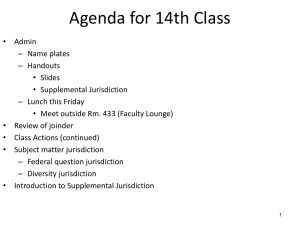Chapter 8
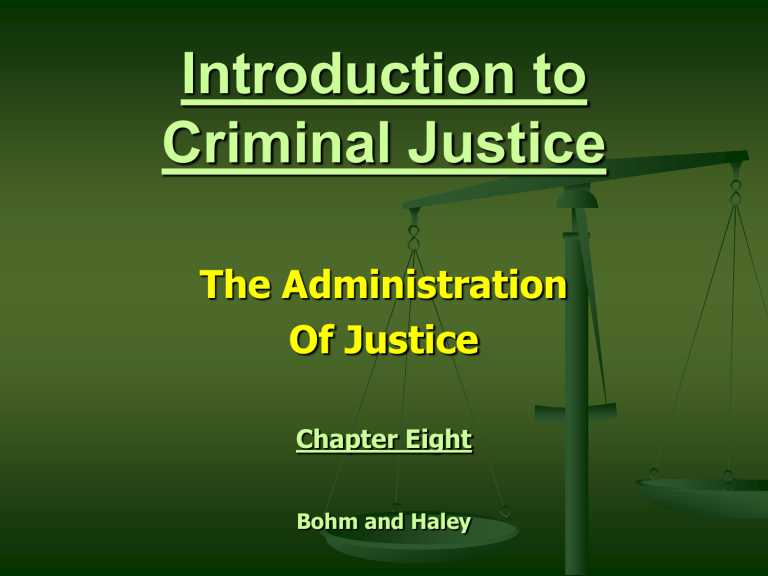
Introduction to
Criminal Justice
The Administration
Of Justice
Chapter Eight
Bohm and Haley
Dual Court System
The court system in the United States consisting of one system of state and local courts and another system of federal courts.
However, it is important to note that there is a separate judicial system for each of the states
(50 separate state systems) and a separate federal system.
Dual Court System of the United States
Jurisdiction
The authority of a court to hear and decide a cases.
Jurisdiction is set by law and is limited by territory and type of case.
Types of jurisdiction include:
Original jurisdiction
Appellate jurisdiction
General jurisdiction
Special jurisdiction
Subject jurisdiction
Personal jurisdiction
U.S. DISTRICT COURTS
There are 94 U.S. District Courts in the U.S. with at least one in every state.
They are courts of original jurisdiction for all major violations of federal criminal law.
The President nominates district court judges and they are approved by the Senate – usually, they serve for life terms.
They handle both civil and criminal cases plus prisoner petitions.
There is one U.S. Attorney per district court who is nominated by the President and confirmed by the Senate (they serve at the pleasure of the President).
District court judges are assisted by bankruptcy judges who are adjuncts of the court appointed by the court of appeals for 14 year terms.
U.S. COURTS OF APPEALS
The U.S. Courts of Appeals are Article III courts.
U.S. Courts of Appeals are also considered as ‘courts of last resort’ which include 12 circuits.
Courts of appeals judges are nominated by the president and approved by the Senate.
Three-judge panels*
Key term: En banc.
U.S. SUPREME COURT
The U.S. Supreme Court is an Article III court that selects which cases it will decide.
Supreme Court justices are nominated by the president and confirmed by the Senate.
The U.S. Supreme Court is composed of nine justices: eight associate and one chief justice.
Writ of certiorari and the rule of four.
The legal issue must involve a federal question; either a violation of federal law or the U.S. Constitution.
They handle approximately 80 cases per year and their decisions are geared to set policy for the entire nation.
Trial Courts of Limited
Jurisdiction*
Trial courts of limited jurisdiction are created, controlled, and funded by city or county governments – they are not part of the state judiciary.
These courts comprise 85 percent of all judicial bodies in the U.S.
The caseload of lower courts represents approximately twothirds of all state court filings.
These courts are restricted in their jurisdiction. Their role focuses primarily on preliminary stages of felony cases, misdemeanor traffic cases, and small claims cases.
* These courts are also called: inferior courts, municipal courts, city courts, magistrate courts, or justice of the peace.
TRIAL COURTS OF GENERAL
JURISDICTION*
These major trial courts have the legal authority to decide all criminal and civil matters not delegated to the lower courts.
State constitutions or statutory law (or both) determine their jurisdiction.
Geographical jurisdiction is usually determined by political boundaries – most often by counties.
Trial courts of general jurisdiction handle juvenile cases, misdemeanor and exclusive felony violations, DWI/DUI cases, and civil matters that are highlighted by domestic relations, estate, and personal injury issues.
* These courts are also known as district, circuit, or superior courts .
INTERMEDIATE COURTS OF
APPEALS
Due to increasing criminal and civil case workloads, states created intermediate courts of appeals. Now, ICAs hear all properly filed appeals.
Most often, these courts (although they exist in only 39 states), handle both criminal and civil cases.
Usually, these courts employ three-judge panels for deciding cases.
Subsequent appeals are at the discretion of the higher court, however, for most litigants, the state’s intermediate appellate court is the final step for most.
COURTS OF LAST RESORT
Courts of last resort do not use judicial panels, instead, the entire judicial body participates in deciding each case (en banc).
These courts have a limited amount of original jurisdiction in matters dealing with legal and judicial personnel.
The docket schedule is purely discretionary. They hear only those cases that tend to have broad legal and political significance.
Courts of last resort are the ultimate review board for matters involving interpretation of state law.
The Courtroom Workgroup
The courtroom actors include judges, prosecutors, defense attorneys, clerks, and probation officers.
There is no hierarchy of tasks.
Each actor is separate and independent.
The courtroom workgroup is mutually interdependent.
Prosecutors and the
Courtroom Workgroup
The prosecutor is the most important member of the courtroom workgroup and influences its members in the following ways :
The prosecutor has sole discretion on whether to charge or not, and subsequently, the type of charge.
The prosecutor controls the nature of the plea bargain; either vertical or horizontal bargaining.
The prosecutor controls the evidence.
The prosecutor controls offender information.
Therefore, by controlling the charge and the plea – the prosecutor can control the sentence.
Socialization, specialization, and informal sanctions keep prosecutors in check.
The
Police
Arrest
The Role of the
Criminal Prosecutor
The
Courts
Initial Appearance
To
Appeal
Corrections
Sentencing
Defense Attorneys
Defense attorneys are officers of the court.
Defense attorneys are members of the courtroom workgroup. Generally, they have the least power.
According to Skolnick, defense attorneys are divided into three categories: those attorneys who handle few cases, those attorneys who have criminal practices and are adversarial, and those attorneys who handle large numbers of clients, i.e., public defenders.
Defense attorneys utilize a reactive approach in response to their continual exposure to various “rewards and sanctions” deemed appropriate by other courtroom workgroup members.
Indigent Defense Systems
Assigned Counsel :
Involves the appointment by counsel by the court of private attorneys from a list of available attorneys.
Contract System :
Involves bidding by private attorneys to represent all criminal defendants found indigent during the term of the contract. (Cost over Quality).
Public Defenders :
Public or private nonprofit organizations with full or part-time salaried staff who represent indigents in criminal cases in their jurisdiction.
Right to Counsel
Steps of Felony Criminal Procedure
Steps Where Counsel Required
Initial Appearance*
Bail*
Preliminary Hearing
Arraignment
Interrogation
Lineup
Plea Bargaining
Trial
Sentencing
1 st Appeal
* If a critical stage .
Steps Where No Counsel
Required
Arrest
Charging
Grand Jury
Lineup (pre-indictment)
Discretionary Appeal
Step Where Lawyer on Request
Interrogation (pre-indictment)
Steps Where Lawyer at Court’s Discretion
Probation and Parole revocations
Judges and the Courtroom
Workgroup
Judges are “reactive” to the actions of other courtroom workgroup members.
Informally, judges share powers with other courtroom workgroup members, i.e., judges accept bail, plea, and sentence recommendations from other courtroom workgroup members.
Judge participation varies between and within jurisdictions, i.e., judge shopping by prosecutors and defense attorneys.
Sanctions are a two-sided sword for the judge and the courtroom workgroup members.
Legal Duties of the Judge
Include the following:
The Judge :
Appoints counsel if necessary.
Signs search warrants if needed.
Sets or revokes bail.
Determines whether there is sufficient probable cause and informs defendant of charges.
Legal Duties of the Judge
Include the following:
(cont’d)
The Judge :
Rules on pretrial evidentiary motions.
Accepts pleas.
Preside over trials if necessary, i.e., rules on evidence and procedures and instructs jury.
Sets punishment.
Arrest to Arraignment
STEPS OF THE PROCESS
Arrest
Initial Appearance
Charging
Preliminary Hearing
Grand Jury
Arraignment
Arrest
Arrest is the physical taking into custody of a suspected law violator.
Arrests by the police is the major source of criminal cases filed in the courts.
Initial Appearance
Defendants are advised of: the charge(s) and their rights; bail is set; and the preliminary hearing date is set.
The initial appearance occurs within a few hours or a few days of arrest.
Misdemeanor defendants can plea and be sentenced; felony defendants cannot.
Bail
The right to bail is established in the
Eighth Amendment’s clause of the
U.S. Constitution which states that,
“excessive bail shall not required.”
However, those defendants accused of a capital offense have no right to bail.
Bail
Bail is a guarantee that upon release from jail, the accused promises to return to court as needed.*
It is not a fine or penalty.
* Stages: arrest, initial appearance, preliminary hearing, arraignment, and conviction.
Forms of bail include:
Cash Bond
Property Bond
Release on Recognizance
Bail Bondsman
Conflicting Theories
Crime Control
The purpose of bail is to protect society; i.e., pretrial crimes and preventive detention.
Due Process
The purpose of bail is to ensure pretrial release and the guarantee that the defendant appears in court, i.e.,
10 percent bail and pre-trial services.
Charging
Formal criminal charges against the defendant stating which criminal law was violated including all criminal elements ( corpus delicti ).
The prosecutor controls the charging decision – whether charges should be filed and what the proper charge(s) should be.
Prosecutors have wide discretion with minimal accountability.
Charging (cont’d)
Types of Charging Documents:
Complaint
Information
Arrest Warrant
Indictment
Preliminary Hearing
A pretrial hearing to determine if there is probable cause to hold the accused for further proceedings, or, in grand jury states, the hearing binds over the accused for possible indictment.
A preliminary hearing can be ‘held’ or ‘waived’ by the defense attorney .
Characteristics of a Grand Jury
Required in some states, optional in other states.
Grand juries are impaneled for a set period of time.
True bill – no true bill.
Grand juries are held in secrecy.
Indictments are rendered by a plurality vote – not a unanimous vote.
Grand juries have the power to grant immunity, i.e., transactional immunity and use immunity.
Characteristics of a Grand Jury
Required in some states, optional in other states.
Grand juries are impaneled for a set period of time.
True bill – no true bill.
Grand juries are held in secrecy.
Indictments are rendered by a plurality vote – not a unanimous vote.
Grand juries have the power to grant immunity, i.e., transactional immunity and use immunity.
Arraignment
A stage in the criminal justice process, where a defendant, in a court of general jurisdiction, is formally informed of the charges of the crime, either from an information or an indictment, and is called upon to enter a plea.
Plea Bargaining
The process through which a defendant pleads guilty to a criminal charge with the expectation of receiving some consideration from the state.
Trial
A trial is the adversarial process of deciding a civil or criminal case in which actors of the courtroom workgroup engage in legal proceedings through presentation of evidence and arguments about the evidence.
The accused, as a member of the courtroom workgroup, shall enjoy the right to a speedy and public trial by an impartial jury of one’s peers.
The Right to Trial by Jury
Jury Trials in Federal
Court
Jury Trials in State
Courts
Constitutional Provisions Constitutional Provisions
Article III, Section 2:
Right to a jury trial for “all” crimes.
The due process clause of the 14 th Amendment incorporates and extends the 6 th Amendments’ right to a jury trial to the states.
Sixth Amendment: Right to a jury trial for “criminal” prosecutions.
Duncan v. Louisiana (1968)
Seventh Amendment:
Right to a jury trial for
“civil” suits.
Scope of the Right to a Jury Trial
Who does not have the right to a jury trial?
Juvenile offenders.
Adult offenders charged with petty offenses – a petty offense equals an offense with an authorized imprisonment of less than six months.
Adult offenders who have made a plea of guilty.
